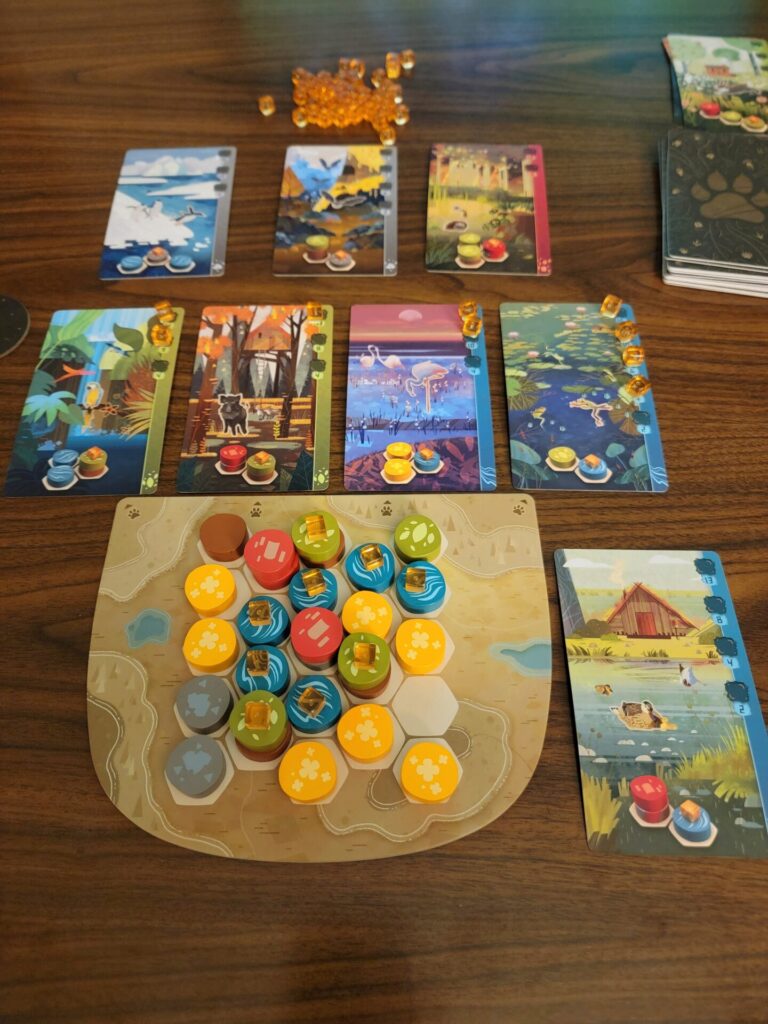
Name: Harmonies
Year of Release: 2024
Player Count: 1 – 4
Playing Time: 30 – 45 Minutes
Designer: Johan Benvenuto
Publisher: Libellud
Primary Mechanisms: Open Drafting, Pattern Building, Tile Placement
Weight (According to BGG.com): 1.94
Overview
Whenever I go out of town, whether it be for work or for a family vacation, I just have to visit a board game store. I wish I could say that I don’t always buy something, but I usually do, but it’s more about just walking around and seeing a store for the first time and enjoying the ambiance of an unfamiliar place. Recently, I had to go to the Dallas/Fort Worth area for work, and I was able to visit Common Ground Games. Not only was the store filled to the brim with all sorts of games, but they also had these end caps set up with games on display. This was an awesome idea that I’m not sure I’ve seen elsewhere. Sure, some stores have demo products on a shelf that you can check out, but being able to walk from aisle to aisle and seeing a different game set up at the end of each one, ready to be played was just a really nice touch.
At the end of one of these aisles was the 2024 release, Harmonies. The colorful, circular tiles immediately caught my eye, as did the beautifully illustrated art cards. Even though, I quickly passed by it as I typically don’t play too many “abstract” games. But as I searched around the store, I kept drifting back to this specific end-cap. Finally, I decided to buy the game, took it back to my hotel room and immediately set it up. Read on to find out what Harmonies is all about and if I think this purchase is worth singing about.
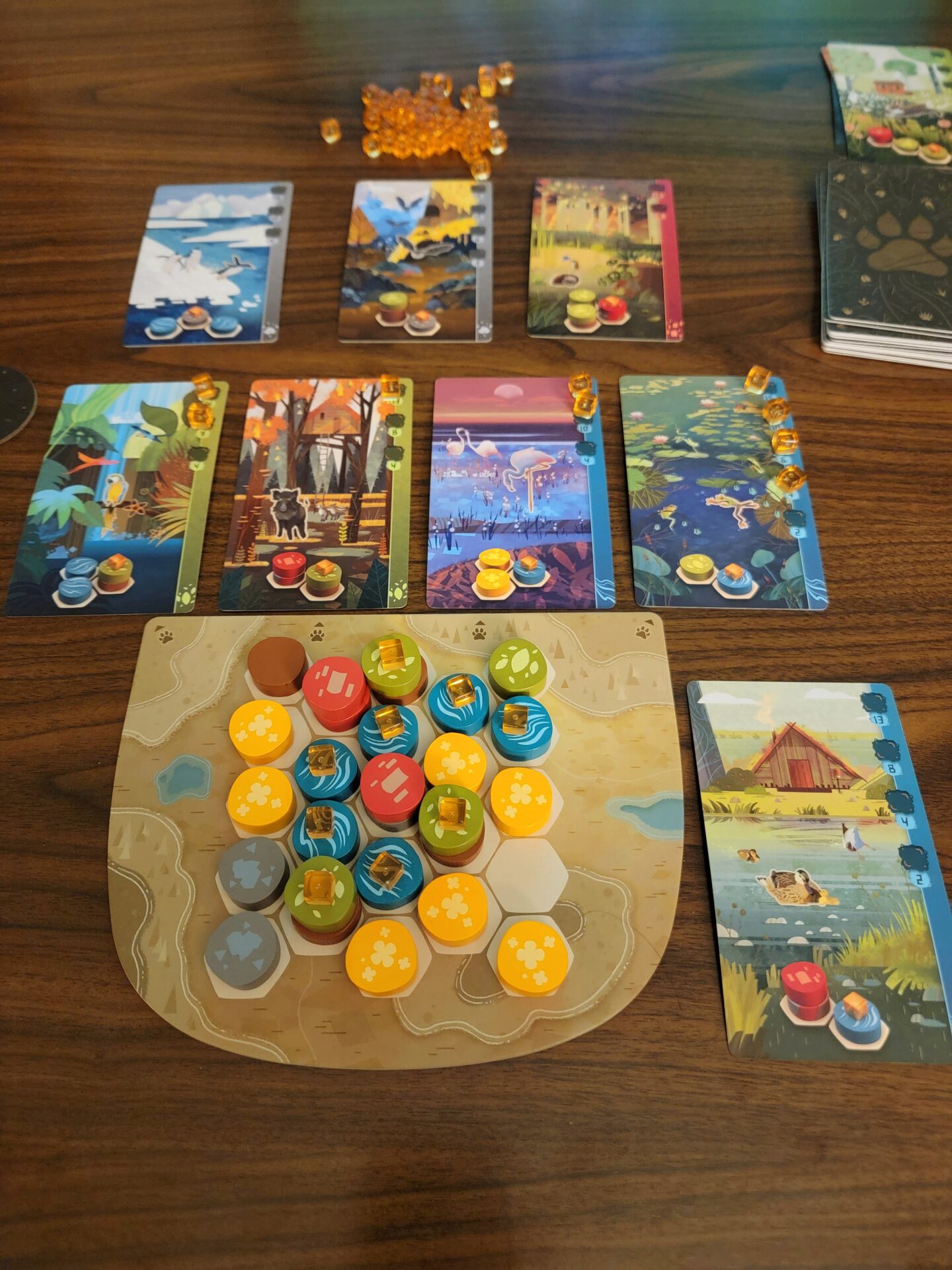
Rulebook & Components
I won’t spend a ton of your time on the rulebook for Harmonies. It does it’s job exceedingly well, with gorgeous, clarifying art and written in a manner that is easy to understand from front to back. I don’t think any players, whether they be new to modern board gaming or old pros, will have a hard time understanding the turn actions and the flow of the game after a read through of the manual.
With that out of the way, let’s discuss components. First off, the game box comes with a pretty cool built in little “shelter” to place the cards in. It has a lid that closes and keeps the cards from sliding all over the place in the box. I can always appreciate when a company goes a little further than just giving players a gaping box, or worse yet, when there is some “insert” in the box that has no rhyme or reason for existing and can’t competently hold any of the included components.
Since I’ve mentioned the cards, we’ll go there next. In the box, you’ll find three kinds of cards: a deck of Animal Cards, a smaller deck of Nature’s Spirit Cards, and four Player Aid Cards. Both the Animal Cards and Nature’s Spirit Cards are similar in looks (though they differ slightly in use) and wow, do they look great. The artist, Maëva da Silva, has worked on Mysterium Park, the beautiful Stella (in the Dixit universe), and the upcoming Azul: Duel. The artwork is playful without being childish and each card has its own atmosphere to it. It’s also amazing how the artwork on each card can relate so perfectly to the Token Pattern (more on this later) found at the bottom of each card. The Player Aid cards are perfect for communicating scoring rules to the player without needing almost any text. I’ve found that Player Aids that are covered in walls of text are rarely used but every person I’ve taught Harmonies to has loved the Player Aid and used it throughout each of their first few games.
Outside of the cards, the other component that drew my eyes that first day I saw the game, was the chunky wooden Landscape Tokens. The tokens come in six different colors, with five of them being printed with a different symbol that ties in perfectly with the card artwork. The sixth token is a plain brown one, mostly used to stack other tokens on top of it so it didn’t really need anything printed on it. The tokens are a wonderful size, maybe a little wider than a quarter, but much thicker, that feels great in your hands.
The remaining components consist of Animal Cubes, small opaque orange cubes made of plastic, four Player Boards and a small Central Board. All of these components are fine, but they obviously pale in comparison to the cards and tokens. I will mention that the individual Player Boards are two sided, giving a slight variation of gameplay between the two. So, all-in-all, the components knock it out of the park, but what about the gameplay?
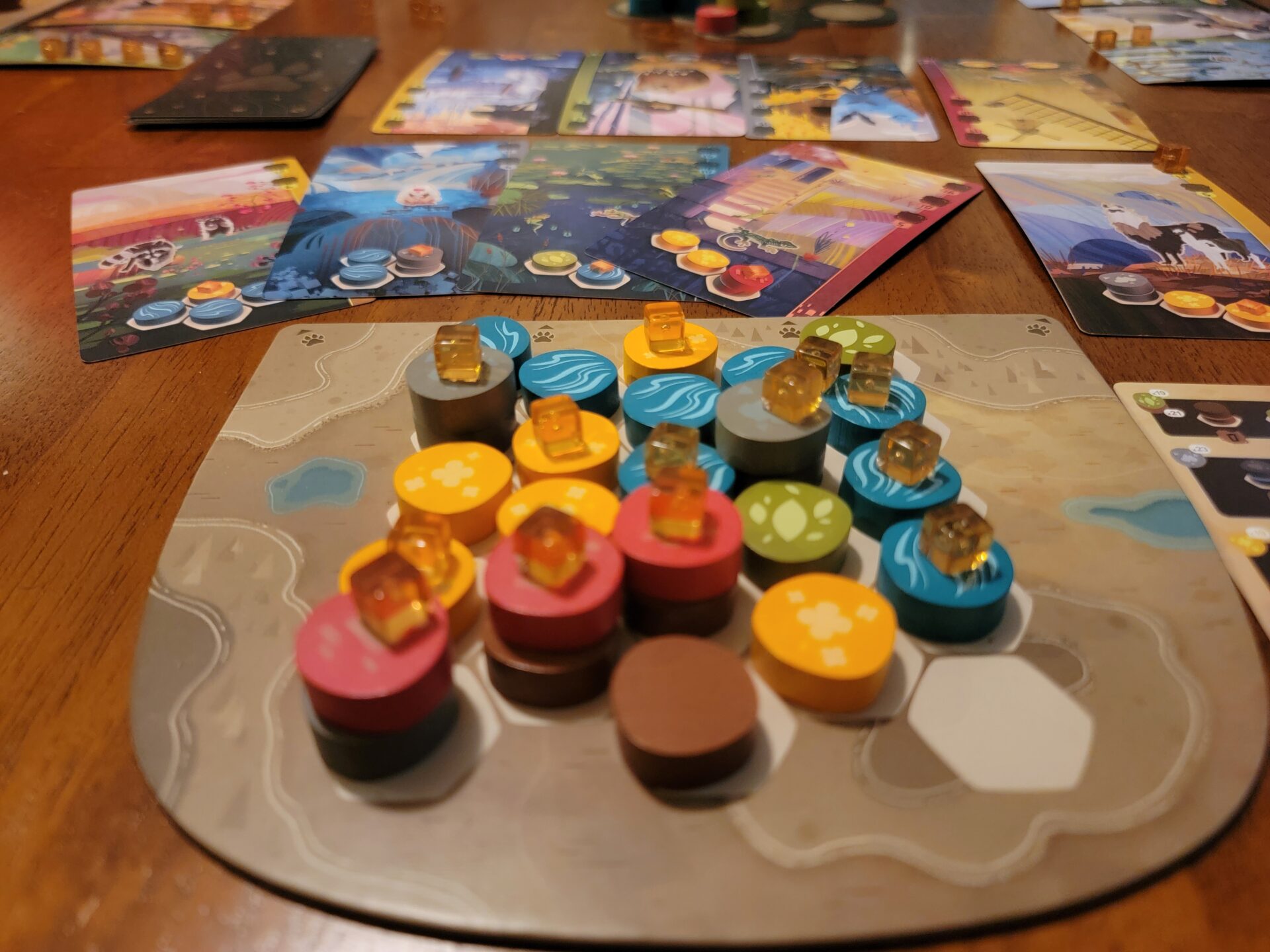
Setup & Gameplay
There’s nothing worse than when, somehow, a game that takes around the 20-to-30 minute mark to play, makes the players spend 10 minutes just to set it up. If it’s a longer game, I can understand, but there just isn’t any reason for it in a smaller game or a filler game. Thankfully Harmonies is quick and easy. Players decide on which side of the board they’ll be using. Someone shuffles the Animal Cards and puts out a row of five and the rest in a draw pile. Each player is given two Nature’s Spirit Cards (if choosing to play with these) and they are to pick one and discard the other. Lastly, the Landscape Tokens are all mixed up in the included bag and then a pile of three tokens is drawn out and placed on each of the five spots on the main Landscape Board. Boom, ready to play!
On a player’s turn, there are three actions they can take, with one of them being mandatory and the other two being optional. First, let’s talk about the mandatory action: picking up a pile of three of the Landscape Tokens from the main board. Once they pick these up, they are to place them into the open spots on their Player Board. While the player does not have to place the tokens touching each other, or even touching tokens that are already placed, there are some rules guiding where to place the tokens depending on their color. For example, a Green Token can be placed in a single stack, or it can be stacked on top of a single Brown Token, or even on top of two Brown Tokens. Similarly, Grey Tokens can be stacked at one, two, or three tokens high, but can only ever stack on other Grey Tokens. All of this information is plainly outlined on the Player Aid to make it easy for new players, but that’s not the only information conveyed on the aid.
Each type of token is scored differently at the end of the game. Going back to the aforementioned Grey Tokens, a stack of three will award a player more points at the end of the game, compared to a stack of a single token, but there’s a catch! An independent stack of Grey Tokens, no matter the height, actually scores zero points! For the stack to be eligible to score points, it has to be “chained” (or touching) at least one other stack of Grey Tokens. Being that the Grey Tokens are symbolizing mountains, this is a perfect way to construct tiny “mountain ranges” on your player board.
Another scoring example is with the Red Tokens, which represent towns or cities. First, a Red Token must be stacked on either a Grey Token, a Brown Token, or another Red Token for it to be eligible to score. Secondly, the eligible token stack has to be touching at least three different colored tokens. For anyone who has played Cascadia, this feels very similar to the scoring conditions on the Animal Cards in that game.
Ok, so you might be thinking, “what are all those Animal Cards for if all the scoring is based on the individual token scoring conditions?” Well friend, the Animal Cards give you even more ways to score points, and they’ll actually probably end up scoring you more points in the grand scheme of things. See, each Animal Card has a Token Pattern illustrated on the bottom of the card, showing a layout of multiple tokens, with one of them being topped with an orange Animal Cube. On a player’s turn, one of their optional actions can be to take one of the five Animal Cards in the market row set up at the beginning of the game. They then place this above their board and fill the appropriate slots on the right-hand side of the card with the required amount of Animal Cubes.
Once taking a card, players will want to try to replicate the pattern somewhere on their board. If they eventually do this, then they can use that third optional action, which is to remove the bottom-most Animal Cube from their card and place it on the appropriate token per the Animal Card they are working on. As players remove the Animal Cubes from the cards, they uncover an increasing amount of Victory Points that will be awarded to them at the end of the game.
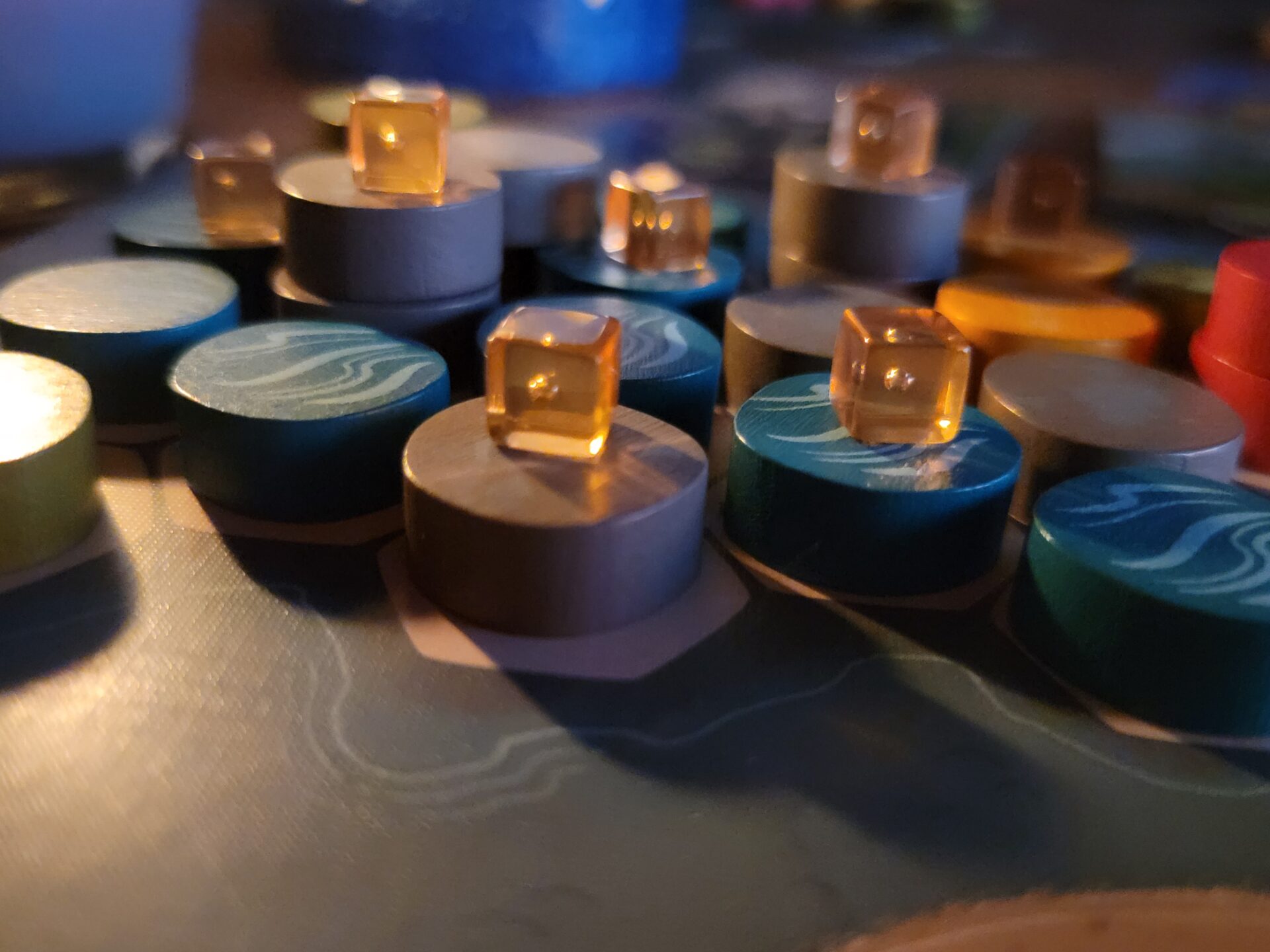
Harmonies does add a nice wrinkle to this part of the game to make it a little more challenging for players. First, players can only ever have four Animal Cards. If they remove all Animal Cubes on a card, then that card can be moved to their completed stack and they are allowed to replace with a market card, either on this turn or future turns. This helps to stop players from hoarding cards and makes them strategically choose the cards they want to pick up, making sure they are ones they actually feel confident about replicating on their board.
Secondly, only one Animal Cube can be on any given Landscape Token, though players can re-use the tokens without the Animal Cube in multiple pattern scenarios. This makes the players stretch their creativity, incentivizing being efficient with their token placements.
If players choose to use the Nature’s Spirit Cards, then the player starts with one of these cards in their inventory, taking up one of the four Animal Card places. The Nature’s Spirit Card only has one cube (this time a simple clear one) and a pattern printed at the bottom similar to the Animal Cards. If the player creates this pattern on their board, they can move the one cube onto the pattern, thus completing the Nature’s Spirit Card. Once completed, this card typically adds another scoring condition to one of the token styles. For example, once you’ve completed the card with the Butterfly artwork, single Yellow Tokens will score points at the end of the game, erasing the penalty that they have to be chained to at least one more Yellow Token to be awarded points. These cards are fun to play with but don’t really change the game too much so it’s not a big deal if your game-mates choose to leave them out.
Solo Mode Thoughts
Like a lot of games being produced nowadays, Harmonies is equipped with a single player mode. It plays pretty similarly to the multiplayer, except the market of Animal Cards is smaller and the player may only choose from a choice of three stacks of tokens, instead of the normal five. Also, the player must put the two stacks they don’t choose back into the box, causing the amounts of each token to start dwindling pretty quickly. It was fun to use to learn the game, but pales in comparison to the multiplayer version. The scoring works the same but for some reason it has you take your final score and convert it into a certain amount of “Suns” which I guess are the solo version of Victory Points. I’m not entirely sure why this was designed this way as it causes a wide range of scores to convert into the same amount of Suns, which really kills the excitement of beating your high score. Many times, I was left thinking, “Well, I think I beat my high score in actuality, but these just converted to five Suns again, much like the last four times I’ve played…”
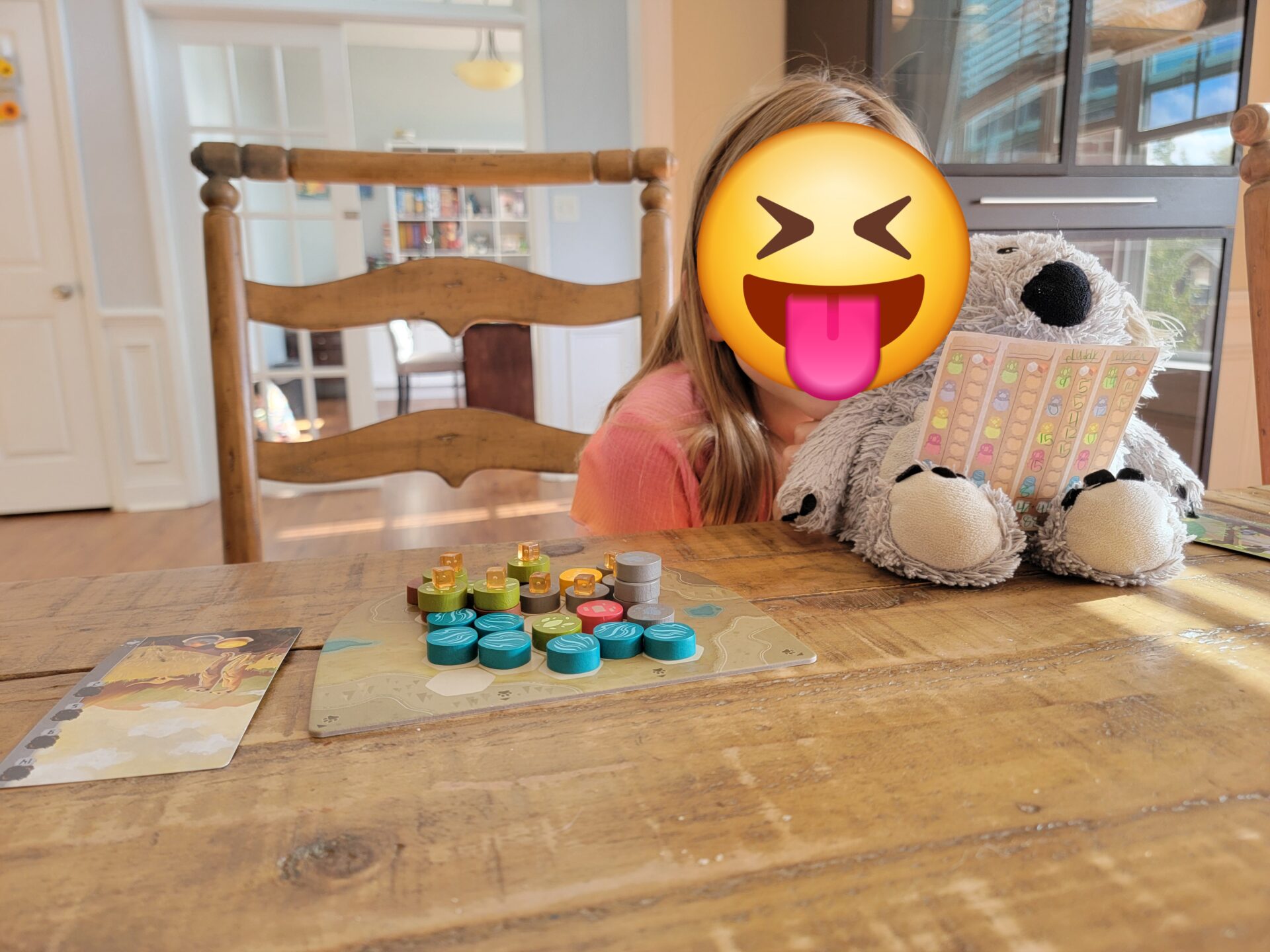
Conclusion
For me, Harmonies hits all the right notes when it comes to a quick and fun abstract game. It’s quick setup time and easy to comprehend rules means that it can definitely be taught to new board gamers or even young players. While I wish the solo mode had more going for it, that’s not necessarily the selling point of this game so I can let that slide.
Rating
Ratings are based on 5 main criteria: rulebook, setup, components, art & graphic design, and gameplay. The first 4 criteria are rated 1 to 5 and the gameplay is rated 1 to 10. These scores culminate in an “overall satisfaction” score that is rated from 1 to 10. If the reviewed game has both a solo and multiplayer mode, I have assigned scores separately to give context to which mode we enjoy more.
Links
As an Amazon Associate I earn from qualifying purchases.
Amazon: Amazon.com: Harmonies Board Game – Create Oneiric Landscapes! Strategic & Poetic Gameplay, Fun Family Game for Kids & Adults, Ages 10+, 1-4 Players, 30 Min Playtime, Made by Libellud : Toys & Games
